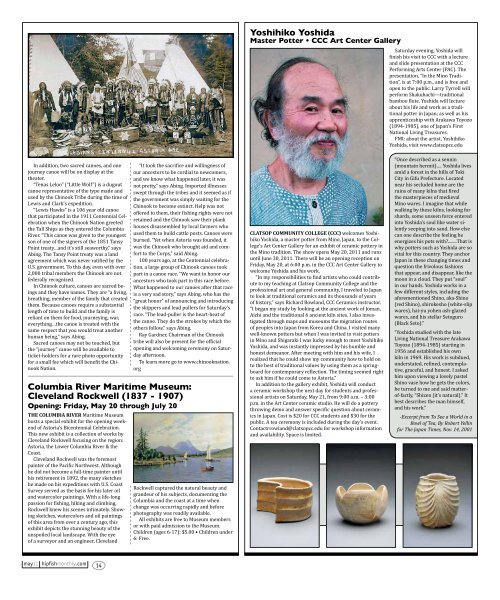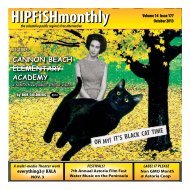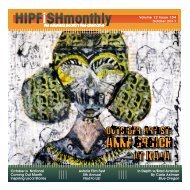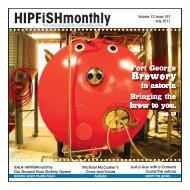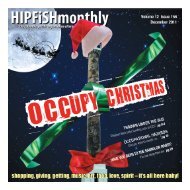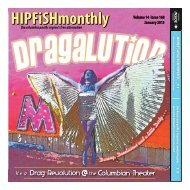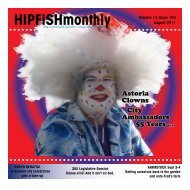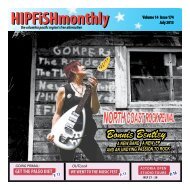HIPFiSHmonthly
HIPFiSHmonthly
HIPFiSHmonthly
- No tags were found...
Create successful ePaper yourself
Turn your PDF publications into a flip-book with our unique Google optimized e-Paper software.
Yoshihiko YoshidaMaster Potter • CCC Art Center GallerySaturday evening, Yoshida willfinish his visit to CCC with a lectureand slide presentation at the CCCPerforming Arts Center (PAC). Thepresentation, “In the Mino Tradition”,is at 7:00 p.m., and is free andopen to the public. Larry Tyrrell willperform Shakuhachi—traditionalbamboo flute. Yoshida will lectureabout his life and work as a traditionalpotter in Japan; as well as hisapprenticeship with Arakawa Toyozo(1894-1985), one of Japan’s FirstNational Living Treasures.FMI: about the artist, YoshihikoYoshida, visit www.clatsopcc.eduIn addition, two sacred canoes, and onejourney canoe will be on display at thetheater.“Tenas Leloo” (“Little Wolf”) is a dugoutcanoe representative of the type made andused by the Chinook Tribe during the time ofLewis and Clark’s expedition.“Lewis Hawks” is a 106 year old canoethat participated in the 1911 Centennial Celebrationwhen the Chinook Nation greetedthe Tall Ships as they entered the ColumbiaRiver. “This canoe was given to the youngestson of one of the signers of the 1851 TansyPoint treaty…and it’s still seaworthy,” saysAbing. The Tansy Point treaty was a landagreement which was never ratified by theU.S. government. To this day, even with over2,000 tribal members the Chinook are notfederally recognized.In Chinook culture, canoes are sacred beingsand they have names. They are “a living,breathing, member of the family that createdthem. Because canoes require a substantiallength of time to build and the family isreliant on them for food, journeying, war,everything…the canoe is treated with thesame respect that you would treat anotherhuman being,” says Abing.Sacred canoes may not be touched, butthe “journey” canoe will be available toticket-holders for a rare photo opportunityfor a small fee which will benefit the ChinookNation.The Columbia River Maritime Museumhosts a special exhibit for the opening weekendof Astoria’s Bicentennial Celebration.This new exhibit is a collection of works byCleveland Rockwell focusing on the region:Astoria, the Lower Columbia River & theCoast.Cleveland Rockwell was the foremostpainter of the Pacific Northwest. Althoughhe did not become a full-time painter untilhis retirement in 1892, the many sketcheshe made on his expeditions with U.S. CoastSurvey served as the basis for his later oiland watercolor paintings. With a life-longpassion for fishing, hiking and climbing,Rockwell knew his scenes intimately. Showingsketches, watercolors and oil paintingsof this area from over a century ago, thisexhibit depicts the stunning beauty of theunspoiled local landscape. With the eyeof a surveyor and an engineer, Cleveland“It took the sacrifice and willingness ofour ancestors to be cordial to newcomers,and we know what happened later, it wasnot pretty,” says Abing. Imported illnessesswept through the tribes and it seemed as ifthe government was simply waiting for theChinook to become extinct. Help was notoffered to them, their fishing rights were notretained and the Chinook saw their plankhouses disassembled by local farmers whoused them to build cattle posts. Canoes wereburned. “Yet when Astoria was founded, itwas the Chinook who brought aid and comfortto the Corps,” said Abing.100 years ago, at the Centennial celebration,a large group of Chinook canoes tookpart in a canoe race. “We want to honor ourancestors who took part in this race before.What happened to our canoes after that raceis a very sad story,” says Abing, who has the“great honor” of announcing and introducingthe skippers and lead pullers for Saturday’srace. “The lead-puller is the heart-beat ofthe canoe. They do the strokes by which theothers follow,” says Abing.Ray Gardner, Chairman of the Chinooktribe will also be present for the officialopening and welcoming ceremony on Saturdayafternoon.To learn more go to www.chinooknation.orgColumbia River Maritime Museum:Cleveland Rockwell (1837 - 1907)Opening: Friday, May 20 through July 20Rockwell captured the natural beauty andgrandeur of his subjects, documenting theColumbia and the coast at a time whenchange was occurring rapidly and beforephotography was readily available.All exhibits are free to Museum membersor with paid admission to the Museum.Children (ages 6-17): $5.00 • Children under6: Free.Clatsop Community College (CCC) welcomes YoshihikoYoshida, a master potter from Mino, Japan, to the College’sArt Center Gallery for an exhibit of ceramic pottery inthe Mino tradition. The show opens May 20, 2011 and runsuntil June 30, 2011. There will be an opening reception onFriday, May 20, at 6:00 p.m. in the CCC Art Center Gallery towelcome Yoshida and his work.“In my responsibilities to find artists who could contributeto my teaching at Clatsop Community College and theprofessional art and general community, I traveled to Japanto look at traditional ceramics and its thousands of yearsof history,” says Richard Rowland, CCC Ceramics instructor.“I began my study by looking at the ancient work of Joman,Aichi and the traditional 6 ancient kiln sites. I also investigatedthrough maps and museums the migration routesof peoples into Japan from Korea and China. I visited manywell-known potters but when I was invited to visit pottersin Mino and Shigaraki I was lucky enough to meet YoshihikoYoshida, and was instantly impressed by his humble andhonest demeanor. After meeting with him and his wife, Irealized that he could show my community how to hold onto the best of traditional values by using them as a springboardfor contemporary reflection. The timing seemed rightto ask him if he could come to Astoria.”In addition to the gallery exhibit, Yoshida will conducta ceramic workshop the next day for students and professionalartists on Saturday, May 21, from 9:00 a.m. – 3:00p.m. in the Art Center ceramic studio. He will do a potterythrowing demo and answer specific question about ceramicsin Japan. Cost is $20 for CCC students and $30 for thepublic. A tea ceremony is included during the day’s event.Contactrrowland@clatsopcc.edu for workshop informationand availability. Space is limited.“Once described as a sennin(mountain hermit)…. Yoshida livesamid a forest in the hills of TokiCity in Gifu Prefecture. Locatednear his secluded home are theruins of many kilns that firedthe masterpieces of medievalMino wares. I imagine that whilewalking by these kilns, looking forshards, some unseen force enteredinto Yoshida’s soul like water silentlyseeping into sand. How elsecan one describe the feeling heenergizes his pots with?........That iswhy potters such as Yoshida are sovital for this country. They anchorJapan in these changing times andquestion the frivolous fashionsthat appear, and disappear, like themoon in a cloud. They put “soul”in our hands. Yoshida works in afew different styles, including theaforementioned Shino, aka-Shino(red Shino), shirokesho (white-slipwares), hai-yu yohen ash-glazedwares, and his stellar Setoguro(Black Seto).”“Yoshida studied with the lateLiving National Treasure ArakawaToyozo (1894-1985) starting in1956 and established his ownkiln in 1969. His work is subdued,understated, refined, contemplative,graceful, and honest. I askedhim upon viewing a lovely pastelShino vase how he gets the colors,he turned to me and said matterof-factly,“Shizen (it’s natural).” Itbest describes the man himself,and his work.”-Excerpt from To See a World in aBowl of Tea, By Robert Yellinfor The Japan Times, Nov. 14, 2001may11 hipfishmonthly.com14


